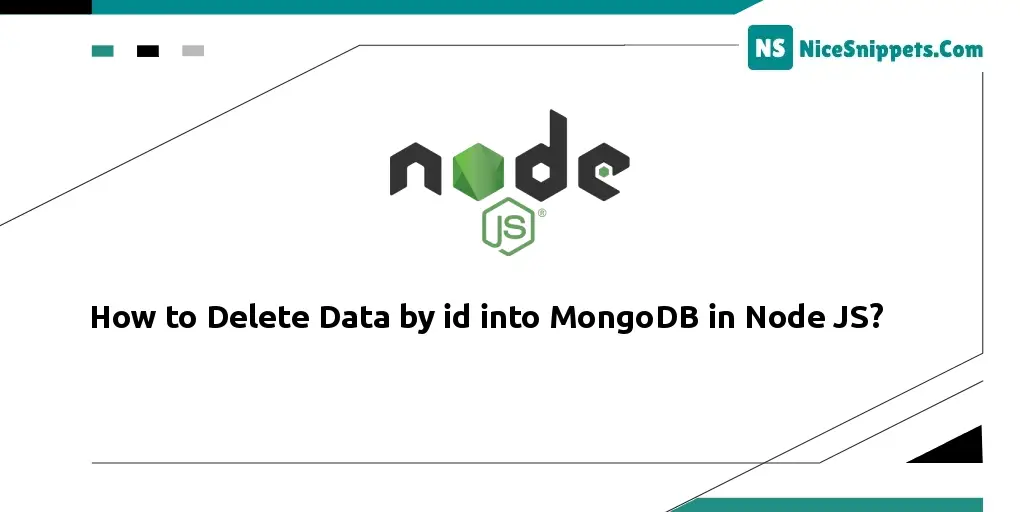27-Mar-2023
.
Admin

Hello Friends,
This example is focused on how to delete data By id from MongoDB database and node js. This article details that we can delete our data in the database using the id method. Here, some basic example is displayed to delete our data from the database.
This tutorial will create a HTML table using the bootstrap 4 libraries and display a list with the delete button. Then create a route and import in an app.js file to delete data from MongoDB mongoose in node js express app.
Step 1: Create Node Express js App
Execute the following command on the terminal to create the node js app:
mkdir my-app
cd my-app
npm init -y
Step 2: Install express flash ejs body-parser mongoose Modules
Execute the following command on the terminal to express flash ejs body-parser MySQL dependencies:
npm install -g express-generator
npx express --view=ejs
npm install
npm install express-flash --save
npm install express-session --save
npm install body-parser --save
npm install mongoose
npm install express-validator cors --save
body-parser – Node.js request body parsing middleware which parses the incoming request body before your handlers, and makes it available under req.body property. In other words, it simplifies incoming requests.
Express-Flash – Flash Messages for your Express Application. Flash is an extension of connect-flash with the ability to define a flash message and render it without redirecting the request.
Express-Session– Express-session – an HTTP server-side framework used to create and manage a session middleware.
Express-EJS– EJS is a simple templating language which is used to generate HTML markup with plain JavaScript. It also helps to embed JavaScript to HTML pages
Mongoose – Mongoose is a MongoDB object modeling tool designed to work in an asynchronous environment. Mongoose supports both promises and callbacks.
Step 3: Connect App to MongoDB
Create a database.js file in your app root directory and add the following code into it to connect your app to the MongoDB database:
var mongoose = require('mongoose');
mongoose.connect('mongodb://localhost:27017/users', {useNewUrlParser: true});
var conn = mongoose.connection;
conn.on('connected', function() {
console.log('database is connected successfully');
});
conn.on('disconnected',function(){
console.log('database is disconnected successfully');
})
conn.on('error', console.error.bind(console, 'connection error:'));
module.exports = conn;
Step 4: Create Model
Create Models directory and inside this directory create userModel.js file; Then add following code into it:
const mongoose = require("../database");
// create an schema
var userSchema = new mongoose.Schema({
name: String,
email:String
});
var userModel=mongoose.model('users',userSchema);
module.exports = mongoose.model("Users", userModel);
Step 5: Create List and Delete Routes
Create routes; so visit routes directory and open users.js route file; Then add the following routes into it:
var express = require('express');
var router = express.Router();
var mongoose = require('mongoose');
var userModel = require('../models/userModel');
/* GET home page. */
router.get('/', function(req, res, next) {
userModel.find((err, docs) => {
if (!err) {
res.render("users/list", {
data: docs
});
} else {
console.log('Failed to retrieve the Users List: ' + err);
}
});
});
// DELETE USER
router.get('/delete/(:id)', function(req, res, next) {
userModel.findByIdAndRemove(req.params.id, (err, doc) => {
if (!err) {
res.redirect('/users/list');
} else {
console.log('Failed to Delete user Details: ' + err);
}
});
})
module.exports = router;
Step 6: Create Views
Create some views; so visit the views directory of your app and create a list.ejs into it.
Create List Page and Delete Button
Create HTML markup for display list from MongoDB database; visit the views directory and create a list.ejs file inside it. Then add the following code into it:
<!DOCTYPE html>
<html>
<head>
<title>How to Delete Data by id into MongoDB in Node JS? - Nicesnippets.com</title>
<link rel='stylesheet' href='/stylesheets/style.css' />
<script src="https://code.jquery.com/jquery-3.3.1.min.js"></script>
<script src="https://stackpath.bootstrapcdn.com/bootstrap/4.1.3/js/bootstrap.min.js" integrity="sha384-ChfqqxuZUCnJSK3+MXmPNIyE6ZbWh2IMqE241rYiqJxyMiZ6OW/JmZQ5stwEULTy" crossorigin="anonymous"></script>
<link href="https://stackpath.bootstrapcdn.com/bootstrap/4.1.3/css/bootstrap.min.css" rel="stylesheet" integrity="sha384-MCw98/SFnGE8fJT3GXwEOngsV7Zt27NXFoaoApmYm81iuXoPkFOJwJ8ERdknLPMO" crossorigin="anonymous">
</head>
<body>
<div> <a href="/" class="btn btn-primary ml-3">Home</a> </div>
<!-- <% if (messages.error) { %>
<p style="color:red"><%- messages.error %></p>
<% } %> -->
<% if (messages.success) { %>
<p class="alert alert-success mt-4">
<%- messages.success %>
</p>
<% } %>
<br>
<table class="table">
<thead>
<tr>
<th scope="col">#</th>
<th scope="col">Name</th>
<th scope="col">Email</th>
<th width="200px">Action</th>
</tr>
</thead>
<tbody>
<% if(data.length){
for(var i = 0; i< data.length; i++) {%>
<tr>
<th scope="row">
<%= (i+1) %>
</th>
<td>
<%= data[i].name%>
</td>
<td>
<%= data[i].email%>
</td>
<td>
<a class="btn btn-success delete" href="../users/delete/<%= data[i]._id%>">Delete</a>
</td>
</tr>
<% }
}else{ %>
<tr>
<td colspan="3">No user</td>
</tr>
<% } %>
</tbody>
</table>
</body>
</html>
Step 5: Import Modules in App.js
Import express flash session body-parser mongoose dependencies in app.js; as shown below:
var createError = require('http-errors');
var express = require('express');
var path = require('path');
var cookieParser = require('cookie-parser');
var logger = require('morgan');
var bodyParser = require('body-parser');
var flash = require('express-flash');
var session = require('express-session');
var usersRouter = require('./routes/users');
var app = express();
// view engine setup
app.set('views', path.join(__dirname, 'views'));
app.set('view engine', 'ejs');
app.use(logger('dev'));
app.use(express.json());
app.use(express.urlencoded({ extended: false }));
app.use(cookieParser());
app.use(express.static(path.join(__dirname, 'public')));
app.use(session({
secret: '123456catr',
resave: false,
saveUninitialized: true,
cookie: { maxAge: 60000 }
}))
app.use(flash());
app.use('/list', usersRouter);
// catch 404 and forward to error handler
app.use(function(req, res, next) {
next(createError(404));
});
// error handler
app.use(function(err, req, res, next) {
// set locals, only providing error in development
res.locals.message = err.message;
res.locals.error = req.app.get('env') === 'development' ? err : {};
// render the error page
res.status(err.status || 500);
res.render('error');
});
module.exports = app;
Step 7: Start App Server
You can use the following command to start the node js app server:
//run the below command
npm start
after run this command open your browser and hit
http://127.0.0.1:3000/list
I hope it can help you...
#Node.js Express
#Node JS